Paradoxurinae
Appearance
| Paradoxurinae | |
|---|---|
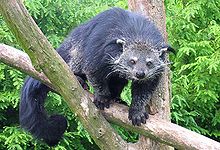
| |
| Binturong(Arctictis binturong) | |
| Scientific classification | |
| Domain: | Eukaryota |
| Kingdom: | Animalia |
| Phylum: | Chordata |
| Class: | Mammalia |
| Order: | Carnivora |
| Suborder: | Feliformia |
| Family: | Viverridae |
| Subfamily: | Paradoxurinae Gray,1864 |
| Genera | |
Paradoxurinaeis asubfamilyof thefeliformviverridsthat was denominated and first described byJohn Edward Grayin 1864.[1]Pococksubordinated thegeneraParadoxurus,PagumaandArctictisto this subfamily.[2][3]
Classification[edit]
Living species[edit]
| Genus | Species | IUCN Red Liststatus and distribution |
|---|---|---|
| ParadoxurusCuvier, 1822[4] | Asian palm civet(P. hermaphroditus)(Pallas,1777)[5]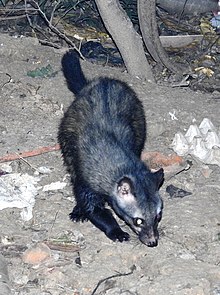
|
LC[6]
|
Golden palm civet(P. zeylonensis)(Pallas, 1778)[7]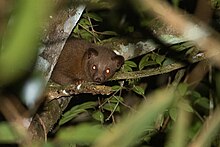
|
VU[8]
| |
Brown palm civet(P. jerdoni)Blanford,1885[9]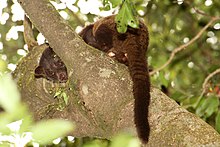
|
LC[10]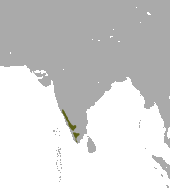
| |
| ArctictisTemminck,1824[11] | Binturong(A. binturong)(Raffles,1822)[12]
|
VU[13]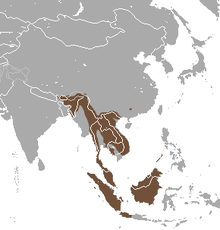
|
| PagumaGray, 1831[14] | Masked palm civet(P. larvata)(Smith,1827)[15]
|
LC[16]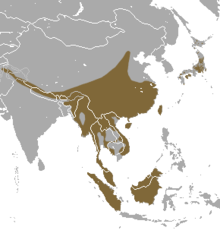
|
| ArctogalidiaMerriam,1897[17] | Small-toothed palm civet(A. trivirgata)(Gray, 1832)[18]
|
LC[19]
|
Phylogenetic tree[edit]
The phylogenetic relationships of Paradoxurinae are shown in the following cladogram:[20][21]
| Paradoxurinae |
| ||||||||||||||||||||||||||||||||||||||||||
Extinct genera[edit]
- KichechiaSavage,1965[22][23]
- TugenictisMorales & Pickford, 2005[24][25]
- KanuitesDehghani & Werdelin, 2008[26][25]
- SiamictisGrohé et al., 2020[27]
References[edit]
- ^Gray, J. E. (1864)."A revision of the genera and species of viverrine animals (Viverridae), founded on the collection in the British Museum".Proceedings of the Zoological Society of London for the Year 1864:502–579.
- ^Pocock, R. I. (1933). "The rarer genera of oriental Viverridae".Proceedings of the Zoological Society of London.103(4): 969–1035.doi:10.1111/j.1096-3642.1933.tb01638.x.
- ^Pocock, R. I. (1939)."Paradoxurinae".The Fauna of British India, including Ceylon and Burma.Vol. Mammalia. Volume 1. London: Taylor and Francis. pp. 376–439.
- ^Cuvier, F. (1822)."Du genre Paradoxure et de deux espèces nouvelles qui s'y rapportent".In Geoffroy Saint-Hilaire, É.; Cuvier, G. (eds.).Mémoires du Muséum d'Histoire Naturelle.Vol. 9. Paris: A. Belin. pp. 41–48.
- ^Pallas, P. S. (1778)."Das ZwitterstinktierViverra hermaphrodita".In Schreber, J. C. D. (ed.).Die Säugethiere in Abbildungen nach der Natur, mit Beschreibungen.Erlangen: Wolfgang Walther. p. 426.
- ^Duckworth, J. W.; Timmins, R. J.; Choudhury, A.; Chutipong, W.; Willcox, D.H.A.; Mudappa, D.; Rahman, H.; Widmann, P.; Wilting, A. & Xu, W. (2016)."Paradoxurus hermaphroditus".IUCN Red List of Threatened Species.2016:e.T41693A45217835.
- ^Pallas, P. S. (1778)."Der BoshondViverra zeylonensis".In Schreber, J. C. D. (ed.).Die Säugethiere in Abbildungen nach der Natur, mit Beschreibungen.Erlangen: Wolfgang Walther. pp. 451–452.
- ^Duckworth, J. W.; Mudappa, D.; Pethiyagoda, R.; Woolgar, J.; de Silva Wijeyeratne, G. & Hall, J. (2016)."Paradoxurus zeylonensis".IUCN Red List of Threatened Species.2016:e.T41694A45218119.
- ^Blanford, W.T. (1855)."Exhibition and description of a skull of an apparently new Species of Paradoxurus (Paradoxurus jerdoni) ".Proceedings of the Zoological Society of London:612–613.
- ^Mudappa, D.; Choudhury, A. & Punjabi, G. A. (2016)."Paradoxurus jerdoni".IUCN Red List of Threatened Species.2016:e.T16104A45201757.
- ^Temminck, C. J. (1824)."XVII GenreArctictis".Monographies de mammalogie.Paris: Dufour & d'Ocagne. p. xxi.
- ^Raffles, T. S. (1822)."XVII. Descriptive Catalogue of a Zoological Collection, made on account of the Honourable East India Company, in the Island of Sumatra and its Vicinity, under the Direction of Sir Thomas Stamford Raffles, Lieutenant-Governor of Fort Marlborough', with additional Notices illustrative of the Natural History of those Countries".The Transactions of the Linnean Society of London.XIII:239–274.
- ^Willcox, D. H. A.; Chutipong, W.; Gray, T. N. E.; Cheyne, S.; Semiadi, G.; Rahman, H.; Coudrat, C. N. Z.; Jennings, A.; Ghimirey, Y.; Ross, J.; et al. (2016)."Arctictis binturong".IUCN Red List of Threatened Species.2016:e.T41690A45217088.
- ^Gray, J. E. (1831)."Paguma".Proceedings of the Committee of Science and Correspondence of the Zoological Society of London.Vol. 1. London: Zoological Society of London. p. 95.
- ^Smith, C.H. (1827)."Gulo larvatus, the Masked Glutton".In Griffith, E. (ed.).The animal kingdom: arranged in conformity with its organization.Vol. 2. Mammalia. London: G.B. Whittaker. p. 281.
- ^Duckworth, J. W.; Timmins, R. J.; Chutipong, W.; Choudhury, A.; Mathai, J.; Willcox, D. H. A.; Ghimirey, Y.; Chan, B. & Ross, J. (2016)."Paguma larvata".IUCN Red List of Threatened Species.2016:e.T41692A45217601.
- ^Merriam, C. H. (1897)."The generic names Ictis, Arctogale, and Arctogalidia".Science.5(112): 302.doi:10.1126/science.5.112.302.PMID17741859.S2CID5336742.
- ^Gray, J. E. (1832)."On the family of Viverridae and its generic sub-divisions, with an enumeration of the species of several new ones".Proceedings of the Committee of Science and Correspondence of the Zoological Society of London.2:63–68.
- ^Willcox, D.H.A.; Duckworth, J. W.; Timmins, R. J.; Chutipong, W.; Choudhury, A.; Roberton, S.; Long, B.; Hearn, A. & Ross, J. (2016)."Arctogalidia trivirgata".IUCN Red List of Threatened Species.2016:e.T41691A45217378.
- ^Gaubert, P. & Cordeiro-Estrela, P. (2006)."Phylogenetic systematics and tempo of evolution of the Viverrinae (Mammalia, Carnivora, Viverridae) within feliformians: implications for faunal exchanges between Asia and Africa"(PDF).Molecular Phylogenetics and Evolution.41(2): 266–278.Bibcode:2006MolPE..41..266G.doi:10.1016/j.ympev.2006.05.034.PMID16837215.Archived fromthe original(PDF)on 2016-10-04.Retrieved2019-07-01.

- ^Nyakatura, K. & Bininda-Emonds, O. R. P. (2012)."Updating the evolutionary history of Carnivora (Mammalia): a new species-level supertree complete with divergence time estimates".BMC Biology.10:12.doi:10.1186/1741-7007-10-12.PMC3307490.PMID22369503.
- ^Savage, R. J. G. (1965)."Fossil mammals of Africa: 19, The Miocene Carnivora of East Africa".Bulletin of the British Museum (Natural History).10(8): 239–316.
- ^Adrian, B.; Werdelin, L. & Grossman, A. (2018)."New Miocene Carnivora (Mammalia) from Moruorot and Kalodirr, Kenya"(PDF).Palaeontologia Electronica.21(1 10A): 1–19.doi:10.26879/778.
- ^Morales, J. & Pickford, M. (2005)."Carnivores from the Middle Miocene Ngorora Formation (13-12 Ma), Kenya"(PDF).Estudios Geológicos.61(3–6): 271–284.doi:10.3989/egeol.05613-668.
- ^abWerdelin, L. (2019)."Middle Miocene Carnivora and Hyaenodonta from Fort Ternan, western Kenya"(PDF).Geodiversitas.41(6): 267.doi:10.5252/geodiversitas2019v41a6.S2CID146620949.
- ^Dehghani, R. & Werdelin, L. (2008). "A new small carnivoran from the Middle Miocene of Fort Ternan, Kenya".Neues Jahrbuch für Geologie und Paläontologie - Abhandlungen.248(2): 233–244.doi:10.1127/0077-7749/2008/0248-0233.
- ^Grohé, C.; Bonis, L. D.; Chaimanee, Y.; Chavasseau, O.; Rugbumrung, M.; Yamee, C.; Suraprasit, K.; Gibert, C.; Surault, J.; Blondel, C.; Jaeger, J.-J. (2020)."The Late Middle Miocene Mae Moh Basin of Northern Thailand: The Richest Neogene Assemblage of Carnivora from Southeast Asia and a Paleobiogeographic Analysis of Miocene Asian Carnivorans".American Museum Novitates(3952): 1–57.doi:10.1206/3952.1.S2CID219296152.
